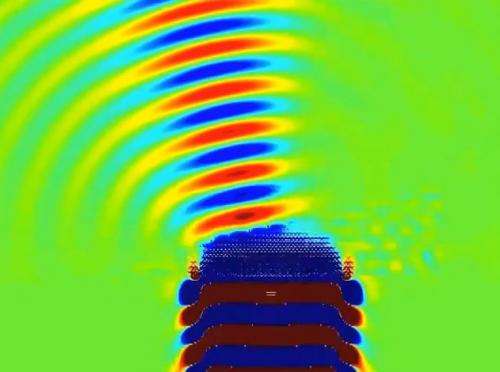Engineers' new metamaterial doubles up on invisibility (w/ Video)

(Phys.org) —The new material's artificial "atoms" are designed to work with a broad range of light frequencies. With adjustments, the researchers believe it could lead to perfect microscope lenses or invisibility cloaks.
One of the exciting possibilities of metamaterials – engineered materials that exhibit properties not found in the natural world – is the potential to control light in ways never before possible. The novel optical properties of such materials could lead to a "perfect lens" that allows direct observation of an individual protein in a light microscope or, conversely, invisibility cloaks that completely hide objects from sight.
Although metamaterials have revolutionized optics in the past decade, their performance so far has been inhibited by their inability to function over broad bandwidths of light. Designing a metamaterial that works across the entire visible spectrum remains a considerable challenge.
Now, Stanford engineers have taken an important step toward this future, by designing a broadband metamaterial that more than doubles the range of wavelengths of light that can be manipulated.
The new material can exhibit a refractive index – the degree to which a material skews light's path – well below anything found in nature.
"The library of refractive indexes that nature gives us is limited," said Jennifer Dionne, an assistant professor of materials science and engineering and an affiliate member of the Stanford Institute for Materials and Energy Sciences at SLAC National Accelerator Laboratory. "All natural materials have a positive refractive index."
For example, air at standard conditions has the lowest refractive index in nature, hovering just a tick above 1. The refractive index of water is 1.33. That of diamond is about 2.4. The higher a material's refractive index, the more it distorts light from its original path.
Really interesting physical phenomena can occur, however, if the refractive index is near-zero or negative.
Picture a drinking straw leaning in a glass of water. If the water's refractive index were negative, the straw would appear inverted – a straw leaning left to right above the water would appear to slant right to left below the water line.
In order for invisibility cloak technology to obscure an object or for a perfect lens to inhibit refraction, the material must be able to precisely control the path of light in a similar manner. Metamaterials offer this potential.
Unlike a natural material whose optical properties depend on the chemistry of the constituent atoms, a metamaterial derives its optical properties from the geometry of its nanoscale unit cells, or "artificial atoms." By altering the geometry of these unit cells, one can tune the refractive index of the metamaterial to positive, near-zero or negative values.
One hitch is that any such material needs to interact with both the electric and magnetic fields of light. Most natural materials are blind to the magnetic field of light at visible and infrared wavelengths. Previous metamaterial efforts have created artificial atoms composed of two constituents – one that interacts with the electric field, and one for the magnetic. A drawback to this combination approach is that the individual constituents interact with different colors of light, and it is typically difficult to make them overlap over a broad range of wavelengths.
As detailed in the cover story of the current issue of Advanced Optical Materials, Dionne's group – which included graduate students Hadiseh Alaeian and Ashwin Atre, and postdoctoral fellow Aitzol Garcia – set about designing a single metamaterial "atom" with characteristics that would allow it to efficiently interact with both the electric and magnetic components of light.
The group arrived at the new shape using complex mathematics known as transformation optics. They began with a two-dimensional, planar structure that had the desired optical properties, but was infinitely extended (and so would not be a good "atom" for a metamaterial).
Then, much like a cartographer transforms a sphere into a flat plane when creating a map, the group "folded" the two-dimensional infinite structure into a three-dimensional nanoscale object, preserving the original optical properties.
The transformed object is shaped like a crescent moon, narrow at the tips and thick in the center; the metamaterial consists of these nanocrescent "atoms" arranged in a periodic array. As currently designed, the metamaterial exhibits a negative refractive index over a wavelength range of roughly 250 nanometers in multiple regions of the visible and near-infrared spectrum. The researchers said that a few tweaks to its structure would make this metamaterial useful across the entire visible spectrum.
"We could tune the geometry of the crescent, or shrink the atom's size, so that the metamaterial would cover the full visible light range, from 400 to 700 nanometers," Atre said.
That composite material probably won't resemble an invisibility cloak like Harry Potter's anytime soon; while it could be flexible, manufacturing the metamaterial over extremely large areas could be tricky. Nonetheless, the authors are excited about the research opportunities the new material will open.
"Metamaterials will potentially allow us to do many new things with light, things we don't even know about yet. I can't even imagine what all the applications might be," Garcia said. "This is a new tool kit to do things that have never been done before."
More information: 'A Broadband Negative Index Metamaterial at Optical Frequencies,' Advanced Optical Materials. doi: 10.1002/adom.201200022
Journal information: Advanced Optical Materials
Provided by Stanford University
















